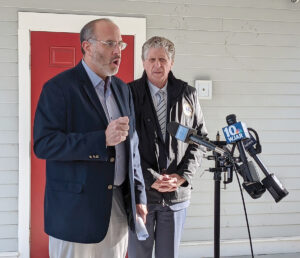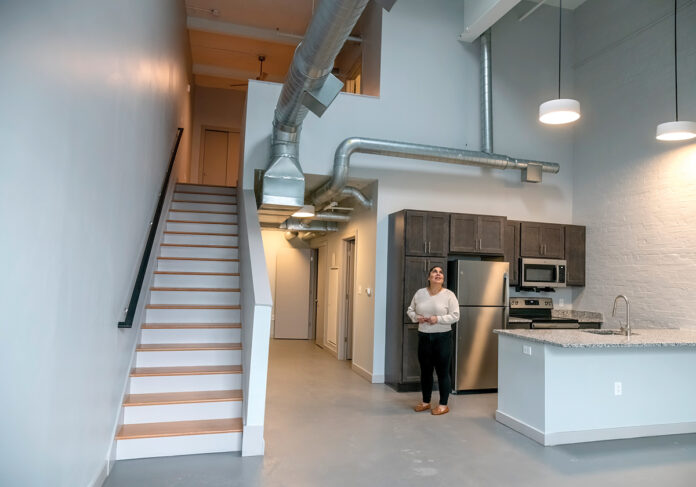For nursing assistant Johnbray Brown, moving into a workforce-rate unit in the renovated Paragon Mill in Providence’s Olneyville neighborhood was a hard-won victory spanning two years, countless inquiries and numerous apartment viewings packed with others in a similar situation.
Brown looked into more places than she can recall, ultimately submitting well over 20 applications, she says – a time-consuming and expensive process.
“Sometimes you wouldn’t get a response, or when you viewed a [home], it was you against so many people at open houses,” Brown said. “You would pay the [application] fee and still wouldn’t get a response or just get a response saying you didn’t get the apartment. So it was a lot of money spent.”
And that was after Brown found housing within her price range – a formidable task in itself.
Brown had already lived in Providence, where she works in a hospital, but after having a child, she needed an apartment with more space.
She found herself on the hunt for a home with many other middle-income workers – health care professionals, teachers, public employees and the like – people she and others feel have been largely left out of the discussions on addressing Rhode Island’s housing shortage.
But now those middle earners looking for an affordable place to live are becoming difficult to ignore, particularly at a time when many companies are struggling to hire mid-level employees in a tight job market. Businesses are finding that the shortage of housing at a modest monthly cost is a big hurdle in recruiting and retaining workers.
The problem has at least one Rhode Island manufacturer contemplating constructing “tiny homes” on company property, a plan that harkens back to the 19th-century factory-owned villages that dotted Rhode Island’s landscape.
Certainly, the concept of “missing middle” housing isn’t new. But the response to a more urgent call for more workforce housing is relatively recent, says James Comer, deputy executive director at the Rhode Island Housing and Mortgage Finance Corp., a quasi-public agency otherwise known as R.I. Housing.
“It’s something that has not necessarily had [as much] attention over the years as the higher and lower income end of the spectrum,” he said.
Rhode Island officials are just now trying to get a better handle on the state’s workforce housing stock and how much is needed. A lot of that work hasn’t happened yet.
The R.I. Office of Housing and Community Development, established in 2022 by Gov. Daniel J. McKee, does not have a tally for the overall number of workforce units available or approved for construction in Rhode Island, says R.I. Secretary of Housing Stefan Pryor, who stepped into the role in February following the resignation of the office’s first leader, Josh Saal.
If all goes as planned, that will change soon, according to Pryor. The OHCD “will be compiling data of every slice of the market,” including workforce units, in the comprehensive housing report legislators tasked the office with developing at its creation, Pryor told PBN.
Not that things have been at a complete standstill statewide.
R.I. Housing established the Workforce Housing Innovation Challenge in 2019 and has since doled out $12.8 million to developers who promised to set aside units in their projects for middle-income workers – in other words, Rhode Islanders earning between 80% and 120% of the area’s median income. That’s $55,150-$82,680 for a single person or $78,750-$118,200 for a family of four, according to the agency.
The developments include the Industrial Trust Co. Building, Studley Building and Case Mead Building in downtown Providence, a building on Parcel 6 in the 195 Redevelopment District, the Strive Lofts at Atwells and Harris avenues in Providence, and the Arctic Mill in West Warwick.
In all, the projects will include 221 workforce housing units out of 780 total. And Pryor says his department will be working with R.I. Housing to determine whether the Workforce Housing Innovation Challenge will provide more funding.
Still, there’s a long way to go in closing the housing gap, observers say, and there are many residents with little time to wait for an affordable place to live.
SLOW GOING
Brown suspects that she avoided much of the competition for workforce housing at Paragon Mill by applying last May, just as the development started accepting applicants. Later on, many did not have success in finding homes, as available units evaporated.
The developer started allowing tenants to move in at the beginning of December, and by February, the complex was 92% occupied, including 49 of the mill’s 57 workforce-rate units. The mill has a total of 101 residential units.
One-bedroom apartment listings at Paragon range from $939 to $1,525 per month, $1,112-$2,175 for a two-bedroom apartment, and $1,270-$2,315 for a three-bedroom unit.
“Demand has been off the charts,” said Dave Vos, project manager for the Paragon Mill, which was redeveloped by the Wisconsin-based Alexander Co. for $35 million. “We made our focus leasing the affordable units first and getting those filled, but certainly, the demand for workforce housing is equally as high.”
Supply, meanwhile, is nowhere near adequate.
It’s no secret that Rhode Island is experiencing a severe housing shortage. And while the Ocean State isn’t alone in grappling with this problem, data shows that Rhode Island lags well behind the rest of the U.S. in correcting it.
In September, Providence nonprofit ONE Neighborhood Builders, drawing from U.S. Census statistics, concluded that Rhode Island ranks last in the nation for single-family building permits issued per capita in 2021, at just 1.27 new housing developments per 1,000 residents.
This finding has echoed across various organizations and studies: On April 24, the Rhode Island Foundation released a 183-page report and action plan on the state’s housing crisis, which found that Rhode Island needs to build another 24,000 affordable housing units to meet demand. In 2021, the state added just 1,150 units, the report said.
Some blame the complicated permitting processes that can differ greatly among Rhode Island’s 39 cities and towns.
At the same time, the state’s single-year housing costs increased at their highest rate since a 2001-2004 surge, according to a 2022 Housing Fact Book published by HousingWorks RI at Roger Williams University. In 2021, the median price for a single-family home rose 14% to $365,000.
Now almost 70% of jobs in state-designated “high-growth sectors” don’t pay enough to support average housing expenses, the report said.
The national average for a “housing wage” – the estimate of the hourly wage a full-time worker must earn to afford a modest rental home – is $24.32 an hour, according to the National Low Income Housing Coalition. In Rhode Island, the housing wage is $34.06, according to HousingWorks RI.
[caption id="attachment_436371" align="aligncenter" width="1024"]

HOUSING HELP: Projects that received $5.9 million in grants to designate workforce housing units include, clockwise from top left, Strive Lofts in Providence (20 units), Arctic Mill in West Warwick (31 units), Studley Building in Providence (14 units) and Case Mead Lofts in Providence (nine units).
PBN PHOTOS[/caption]
A PROBLEM FOR BUSINESS
Employers are noticing the workforce housing difficulties.
In a survey released by the Greater Newport Chamber of Commerce in late 2022, about 65% of 60 businesses surveyed in Newport and Bristol counties said that a continuing struggle to find and retain workers remains a cause for anxiety. A major contributor to the problem is a lack of workforce housing available for rent or purchase, the respondents said.
On Aquidneck Island, which has a higher median cost of living, more workers are commuting from southeastern Massachusetts or elsewhere in Rhode Island. Although the region has added nearly 3,200 workers since 2019, nearly half of them drive in daily from outside Aquidneck Island, says Erin Donovan Boyle, Chamber executive director.
That’s largely because of increasing home costs, fewer available rental units and wages that can’t keep pace, she says.
In the past five years, the median home price in the Greater Newport area, which includes Newport and Bristol counties, increased by 44%, according to a Greater Newport Chamber of Commerce study. And wages haven’t kept up with this trend: Manufacturing sector wages grew by 37%, food service by 35%, and science, technology and health care by just 15%.
Meanwhile, property owners seeking bigger profits have converted more houses and apartments to short-term vacation rentals with the growth of online platforms such as Airbnb Inc. and VRBO.
Employees at the Haven Collection Inc., a child care, coworking and fitness space in Middletown, have been feeling the impact of surging prices, says Haven co-founder Brittany Riley.
The business pays employees $9 above the average industry wage, in addition to providing full benefits, Riley says. Still, some employees are driving in from as far as New Bedford – a roughly 40-minute commute before rush-hour traffic – to live in cheaper housing.
“It’s nearly impossible for someone to actually live on Aquidneck Island without making, easily, a six-figure income,” Riley said. Finding an affordable, year-round rental “is a needle in the haystack at this point on the island.”
One of Haven’s clients, a real estate agent, has started volunteering her services as an informal perk, Riley says, which has helped some employees through the arduous housing search process.
“That’s not a long-term solution, though,” Riley said.
Employers in other areas of the state are going through a similar struggle.
Karl Wadensten, CEO and president of the manufacturer VIBCO Inc. in rural Richmond, describes the housing situation for many of his 100 employees as “dire.”
“I hear it from my people here all the time,” said Wadensten, who is a longtime R.I. Commerce Corp. board member. “They’re all struggling to find places that are affordable, places that are clean, places that are safe.”
Wadensten lays some of the blame on the bureaucracy, red tape and long, drawn-out processes that are too slow to keep up with the growing urgency of housing needs.
Because of that, Wadensten has investigated less-conventional approaches to assist his workers. That includes a proposal for on-site, company-funded units that would allow VIBCO employees to make affordable rent payments that contribute to 401(k) accounts as well.
Wadensten says the proposal seemed to appeal to McKee and General Assembly leaders last year. But since that time, the proposal has gone nowhere at the state level, though he continues to pursue it. He initially planned on duplex-style housing units but is now working with a company in western Massachusetts to order “tiny house” units.
Wadensten is still working out how the permitting process would apply to such units, but even just cutting back on construction time would make a big impact, he says.
“If I build traditional houses, that takes four to five months,” Wadensten said. The tiny houses, he hopes, would speed up the process and lead to more units for the same price.
House Speaker K. Joseph Shekarchi says he sees potential in the concept, calling Wadensten’s efforts “great ideas.” But the speaker says it has a way to go before it can be implemented at a wider level.
“I appreciate Karl’s passion and I share his vision, but it’s great to have an idea, another thing to implement it,” he told PBN. “I encourage Karl to bring those ideas to the low and moderate [income] commission, as well as the land use commission.”
[caption id="attachment_436370" align="alignleft" width="300"]

FACING A CHALLENGE: R.I. Secretary of Housing Stefan Pryor, left, and Gov. Daniel J. McKee attend a news conference on the state’s housing crisis in February, shortly after Pryor was appointed.
PBN FILE PHOTO/JACQUELYN VOGHEL[/caption]
THE FOUR C’s
Many housing advocates see the significance in the $250 million allocation toward housing production that was included in the state’s fiscal 2023 budget, including $100 million set aside for creating more affordable housing.
But funding is only part of the equation, observers agree.
Scott Wolf, executive director of Grow Smart Rhode Island, says investing in the state’s housing stock requires what he calls the “four C’s”: cash, capacity, creativity and coordination.
While the fiscal 2023 budget makes a major cash contribution toward housing development, the state in many ways lacks action on the other three components, Wolf says.
The state’s lack of workforce housing also stems from red tape, and from local zoning laws that often prohibit certain types of development and discourage developers from trying to work with cities and towns.
Permitting and financing play the most prominent roles in getting a housing development completed, says Frank Spinella, president of the Newport-based FJS Associates Ltd. consulting and project development firm.
Spinella has witnessed these obstacles in his work with the nonprofit East Bay Community Development Corp., which owns and manages about 340 apartments in Bristol, Warren and Barrington.
Palmer Pointe, a 13-building complex of townhouses with 46 units – most of them affordable housing – that opened in 2019 in Barrington, remained on the drawing board for about five years due to permitting, legal and financing barriers, Spinella says – and that was with support from local officials, an advantage not all developments have.
“The town had approved [the development] and had been very supportive, but the neighbors appealed it, so we had to wait through the Superior Court process,” Spinella said.
The EBCDC also needed funding from R.I. Housing to proceed, Spinella says, but competition is fierce. R.I. Housing gets 10 or 12 applications per year for affordable housing grants and typically awards three or four.
“If you don’t get funded the first time, you have to wait a whole other year,” Spinella said. “So that’s two years right there in permitting.”
With the $250 million allocated in the $13.6 billion state budget this fiscal year, Shekarchi has led the charge to lower regulatory barriers that developers face, as well as improve affordability for tenants.
This legislative session, the Warwick Democrat unveiled a package of 14 bills intended to streamline the housing permitting process and incentivize developers to create affordable units.
Among those proposals are bills that would standardize permitting processes across municipalities; remove components of multistep hearing and appeals processes; eliminate rental application fees for tenants; and establish a transit-oriented development pilot program to promote high-density development around train and bus hubs.
Another bill in the package extends the Special Legislative Commission to Study Rhode Island’s Low and Moderate Income Housing Act for another two years. Also extended would be the term of the Special Legislative Commission to Study the Entire Area of Land Use, Preservation, Development, Housing, Environment and Regulation.
None of the bills include initiatives specifically targeted at the 80%-120% area median income earners that the state generally considers its workforce population. But Shekarchi says many measures, including those encouraging transit-oriented developments and adaptive reuse, pair naturally with the middle housing concept.
Meanwhile, cities and towns have a vital role to play in increasing workforce and affordable housing supply, Shekarchi says, but few have stepped up to the plate. For example, he says, the fiscal 2023 budget allocates $10 million to various housing authorities to dedicate toward increasing low-income housing stock. But so far, “no one has come forward to claim that $10 million, or a portion of it, to create more low-income housing,” Shekarchi said.
State Rep. June Speakman, who chairs the Special Commission to Study the Low and Moderate Income Housing Act, echoes a need to investigate beyond financial barriers for developers.
“We have $250 million to build housing, and that’s wonderful,” said the Bristol Democrat. “And for people who have been in this business for a long time, it’s more than they’ve had in a long time. But it’s not just about money.”
Municipalities aren’t always limiting developers with arbitrary red tape, Speakman says, noting that some regulations are in place to protect environmental areas and ensure safe infrastructure.
“It does require a fairly deep dive into the whole pattern of development in Rhode Island,” Speakman said, adding that she didn’t believe the commission would have all the answers by the end of the legislative session.
Meanwhile, the pipeline is still filled with potential workforce housing projects.
R.I. Housing has already received numerous applications for new construction and adaptive renovation projects that collectively seek more than the $20 million in federal dollars that’s available now to build on what’s been done through the workforce housing challenge, Comer says.
And while funding hasn’t been enough to solve the issue, Comer says that the workforce housing challenge demonstrated that landlords and developers are “willing to restrict the rents they get for those [workforce units],” in return for initial funding.
“They see the value in getting some upfront capital to build the project in the first place,” Comer said. In return, R.I. Housing gets a 30-year deed restriction.
“We called it a challenge to see if there was proof of concept,” he said. “And that’s what happened. It’s what led us to push for [the $20 million]” for a new middle-income program.















